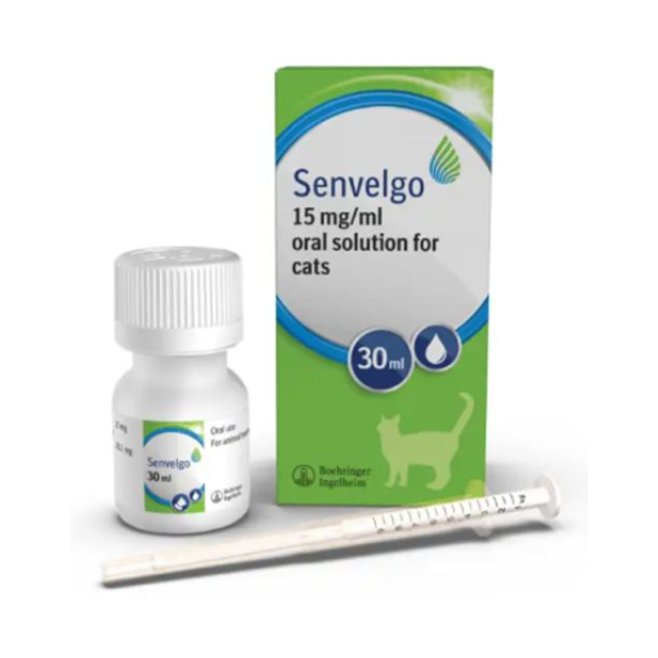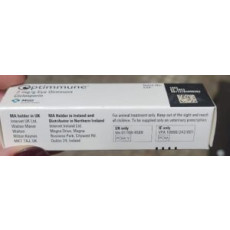SENVELGO 15MG/ML ORAL SOLUTION FOR CATS 30Ml POM-V
![]() Available
Available
Product Description
Target species
Cat
Indications for use, specifying the target species
For the treatment of diabetes mellitus in cats
Amount(s) to be administered and administration route
The recommended dosing regimen is 1 mg/kg body weight once daily. The dosing regimen is the same regardless of prior treatment with insulin or another anti-diabetic medicinal product.
When transitioning from insulin, omit the insulin evening dose the day before starting velagliflozin treatment.
The solution should be drawn up using the dosing syringe provided in the package. The syringe fits onto the bottle and has a kg body weight scale, with 0.5 kg increments. The product may be administered either directly into the mouth or with a small amount of food, to ensure the entire dose is taken at once.
The medication should be given at approximately the same time every day.
If a dose is missed, it should be given as soon as possible on the same day.
After administration close bottle tightly with the cap. Do not wash the syringe with water.
Contraindications
Do not use in cats with evidence of diabetic ketoacidosis, diabetic ketonuria, or severe dehydration requiring i.v. fluid supplementation (see also section 'special precautions for use in animals').
Do not use in cases of hypersensitivity to the active substance or to any of the excipients.
Special warnings for each target species
The safety and efficacy of a combined treatment with insulin or other blood glucose lowering treatments (excluding diet) and velagliflozin in cats has not been investigated. Due to the mode of action of insulin, there is an increased risk for hypoglycaemia, therefore combined treatment is not recommended. Concomitant therapy with other antidiabetics has not been evaluated and may increase the risk for symptomatic hypoglycaemia.
In clinical trials, hypoglycaemia (defined as serum blood glucose levels below 3.5 mmol/l) was sporadically observed, although was asymptomatic and did not demonstrate a causal relationship to the product. Based on the selectivity of velagliflozin for the SGLT-2, there is no risk for symptomatic hypoglycaemia (glucose reabsorption will be balanced by the SGLT-1).
Based on the mode of action it is expected that cats being treated with SGLT-2 inhibitors will exhibit glucosuria. Therefore, the degree of glucosuria is not a reliable diagnostic indicator for monitoring diabetic control or diabetic remission. As glucosuria may persist for 2-3 days after discontinuation of the veterinary medicinal product, blood glucose levels should be monitored to determine when diabetic treatment needs to be resumed.
Special precautions for use
Special precautions for use in animals:
The following conditions should be resolved prior to treatment start: dehydration, suspected or confirmed diabetic ketoacidosis, clinical pancreatitis, chronic diarrhoea, cachexia.
Prior to initiating treatment, screening for ketoacidosis should be performed. Clinical signs such as dehydration, lethargy, anorexia (inappetence), acute vomiting, cachexia alongside hyperglycaemia and presence of serum or urine ketone bodies may indicate that the cat has DKA or may be at higher risk of developing DKA. Insulin pre-treated cats may be at higher risk for DKA (see below).
In field studies conducted with the veterinary medicinal product 14/277 (5.1%) of the cats that had previously not received any treatment for DM developed clinical DKA whereas 8/66 (12.1%) of cats that had previously been treated with insulin developed clinical DKA. The likelihood of pancreatic beta-cell loss and insulin-dependency may be higher in insulin pre-treated cats. As a result, the withdrawal of the insulin before the start of treatment with the product may lead to a metabolic destabilisation and initiate ketogenesis. This information should be taken into account when considering transferring a cat from insulin treatment to treatment with this veterinary medicinal product.
In line with DM treatment guidelines, cats should also be evaluated for concurrent disease including pancreatitis, infectious disease, urinary tract infection, neoplasia, and acromegaly as these conditions may increase the risk of developing ketoacidosis.
Cats may also require temporary discontinuation of therapy in clinical situations known to predispose to ketoacidosis (e.g. prolonged fasting due to acute illness, around surgery).
Cats considered to be at risk of developing diabetic ketoacidosis need close monitoring after initiation of treatment. The risk of developing diabetic ketoacidosis significantly decreases after the first two weeks of treatment, but DKA may occur at any time (see monitoring/precautions below).
Diabetic ketoacidosis (DKA) and ketonuria: Discontinue treatment immediately in the event of confirmed or suspected DKA or diabetic ketonuria and investigate accordingly. Due to the mode of action of SGLT-2 inhibitors, DKA may present without hyperglycaemia (known as euglycaemic DKA). A check for ketone bodies is therefore required prior to use and/ or whenever DKA is suspected; treatment with Senvelgo should not be initiated whilst urine ketone bodies are detected.
Diagnosis of euglycaemic DKA can be based on the presence of ketone bodies and euglycaemia alongside clinical signs such as decreased appetite, acute vomiting, lethargy and dehydration. The presence of ketone bodies should prompt further evaluation of the cat; in cases of clinical DKA, it is imperative to initiate treatment in accordance with standard DKA treatment protocols. This includes the prompt initiation of insulin therapy, administration of dextrose or other carbohydrate source as well as appropriate nutritional support. Checking for ketones is required at the initiation of therapy and every 1-3 days for the first two weeks, as well as whenever the cat is showing clinical signs of illness.
Delay in diagnosis and treatment of diabetic ketoacidosis and euglycemic diabetic ketoacidosis may result in increased morbidity and mortality.
The safety and efficacy of the product has not been established in cats younger than 9 months and 4 years, respectively.
The safety and efficacy of the product has not been fully evaluated in severe cases of renal/liver/cardiac disease. Use only according to the benefit/risk assessment by the responsible veterinarian.
Remission:
Remission of diabetes mellitus in cats is a complex phenomenon, which can be influenced by multiple factors in individual patients, such as glycaemic control, diet, age, weight, and/or genetics. Due to velagliflozin’s mode of action it may be difficult to identify cats which are in remission, since they would not be expected to have hypoglycaemic events (unlike therapy with insulin). Consideration could be given to either continuing treatment with velagliflozin indefinitely or withdrawing treatment and closely monitoring glycaemic control and for return of clinical signs. If the patient relapses then velagliflozin treatment can be restarted.
Routine monitoring recommendations:
Cats with diabetes mellitus and treated with the veterinary medicinal product should be routinely monitored according to standard DM treatment guidelines. In addition, due to the mode of action of velagliflozin, routine monitoring should include urinalysis (ketonuria, UTI), hydration status (osmotic diuresis) and body weight (unintended body weight loss due to persistent glucosuria).
Whenever clinical signs of DKA occur the cat should be evaluated for the presence of ketone bodies (e.g. ketonuria) indicating DKA or comorbidities causing insulin resistance. If the cat’s clinical condition declines and/or blood glucose or fructosamine values worsen after initial improvement, additional diagnostics or alternative therapies may be required. Evaluation of haematology, serum chemistry, urinalysis and hydration status is recommended.
Due to their mode of action, SGLT-2 inhibitors may cause a mild increase in serum creatinine, BUN, phosphorus, and sodium within weeks of starting therapy, followed by a stabilisation of values. Routine evaluation of renal function, body weight and hydration status in patients with renal disease is recommended.
Special precautions to be taken by the person administering the veterinary medicinal product to animals:
Accidental exposure to the product may cause increased urination, and symptoms of low blood pressure or low blood sugar, such as dizziness.
Take care to avoid children accessing an unattended filled syringe.
Do not leave the syringe unattended. Ensure that the food bowl is washed after the cat has eaten food which was mixed with the product.
If skin contact occurs, avoid hand-to-mouth contact, and wash hands immediately.
If symptoms occur, seek medical advice.
The product may cause slight irritation to the eyes.
Avoid contact with the eyes.
If contact with the eyes occurs, rinse immediately with water, and seek medical advice if symptoms persist.
The product includes propylene glycol, which may cause hypersensitivity reactions. People with known hypersensitivity to this substance should avoid contact with the product.
As no data are available to conclude that exposure to velagliflozin presents a risk to pregnant and/or breastfeeding women, they should consider wearing gloves in addition to standard hygiene practices.
Loyalty Scheme
Earn up to 175 loyalty points with this product.







Share
SENVELGO 15MG/ML ORAL SOLUTION FOR CATS 30Ml POM-V
Facebook Twitter Email Pinterest Telegram